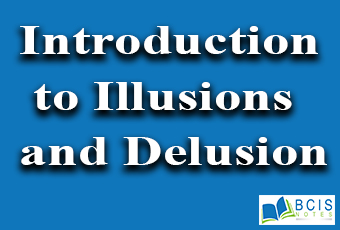
Introduction to Illusions and Delusion:
Illusions
Perceptual illusions are a false perception. They are the misinterpretations or interpretations of stimuli that do not correspond to the stimulus received by the eye or other senses. For example; the grass looks greener on the other side of the fence. Illusions may occur because of confusion, eye movement, perspectives, emotion, contrast perception, habits, defect of the sense organs and tendency toward wholes. It is all about Introduction to Illusions and Delusion.
Types of Illusions
- Illusions due to physical processes
- Illusions due to cognitive processes
Illusions due to physical processes:
The illusions are perceived without any existence of the stimulus. Those is things that are not really there. For example; Mirage is an optical illusion in which the image of an object, oasis or water appears on a dry road. These illusions are something that falsely appears to be real.
Illusions due to cognitive processes:
Cognitive illusions occur in the presence of the stimulus but the individual simply misinterprets the situation or the stimulus. Their two categories are:
- Illusion of size
- Illusion of shape
The illusion of size:
It occurs because we perceptually distort the length of various lines. Learning also plays an important role in perceiving illusions of size. Examples; Multilayer illusion- both arrowheads and the feather-headed lines are of the same length but the one with feather-headed looks long or bigger.
The illusion of shape or area
It suggests that the geometrical stimulus is the other cause to mislead the perception. Examples;
- Moon Illusions: The moon looks bigger at the horizon than at its highest point in the sky.
- Sander’s Illusions: Sander’s or parallelogram illusion- The AC diagonal appears about the same length as BC but it is 16% shorter.
Delusions and Hallucinations:
They are the abnormal reactions to the perception. They are also regarded as neurotic and psychotic symptoms. The perception is identical to normal persons whereas hallucinations and delusions vary with the individual in illusions.
Delusions are unusual subjectivity determined beliefs that are out of harmony with an individual’s education and surroundings. It can be classified into:
- Delusions of persecution
- Delusions of grandeur
- Hypochondriacal Delusions
- Self-condemnatory Delusions
- Ideas of reference
Hallucinations:
It is the sensory perception in the absence of external sensory stimuli. For example; an individual hears voices when there is no sound. It is classified into:
- Auditory
- Visual
- Olfactory
- Gustatory, etc
You may also like Perceptual Constancy and Motion Perception

Leave a Reply